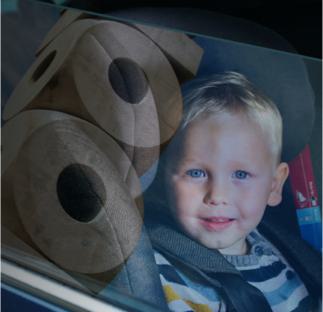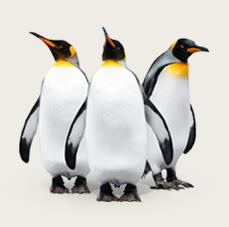Update: Dec. 10, 2025
“Spotted” in Big Cat Country — Amur leopard cubs Vasilisa (Vasa) and Domovoi started exploring their public habitat on Nov. 25! These 3-month-old cubs are slowly getting to know the great outdoors alongside their mom, Dot. The curious, brave pair are already climbing, running and playing during their time outside.
The leopard cubs are now exploring the habitat at their own pace with their mother Dot and can choose to go outside or stay in their private den. Appearances are irregular and are not guaranteed as they adjust to the sights and sounds of their public habitat.
Update: Oct. 21, 2025
A little bit of folklore, a lot of personality. Meet Vasilisa and Domovoi, our 2-month-old Amur leopard siblings! Female cub Vasilisa (Vasa for short) is named for the clever and courageous princess from Russian folklore, known for her wit and beauty. Male cub Domovoi (pronounced doe-ma-voy) is named for the friendly house spirits of Slavic legend. These playful protectors keep an eye on your home but they also love a bit of mischief.
Amur leopards are native to the mountain forests of southeastern Russia, making these names a fitting tribute to the region where this species lives in the wild. It will be a few months before Vasa and Domovoi make their public debut.
Update: Oct. 8, 2025
It’s official! Our Amur leopard cubs are a brother-sister duo. 💙💗
The cubs recently had their first check-up with one of our Zoo veterinarians. During the check-up, they were weighed, had a physical exam and received their first round of vaccines. The siblings are growing fast! They’ve already started leaving the maternity den to explore new spaces. Keepers have also introduced the cubs to sensory experiences such as sod, shavings and toy-like objects. These enrichment items spark curiosity and encourage play!
Dot and her cubs are still bonding behind the scenes in their private maternity den. It’ll be a few months before they’re ready for a public debut.
Aug. 27, 2025
ST. LOUIS — Two critically endangered Amur leopard cubs were born on Aug. 13, 2025, at the Saint Louis Zoo. The births mark an important contribution to the population of one of the most endangered big cats in the world with only about 100 remaining in the wild.
This is the second litter for 7-year-old parents Dot and Samson. Dot and the cubs are doing well and bonding in their private, indoor maternity den. It will be several months before the leopard family makes a public debut at the age when cubs would naturally leave the den with their mother. Samson can be seen by Zoo guests in his habitat at Big Cat Country.
“As a second-time mom, Dot knows exactly what to do,” said Julie Hartell-DeNardo, Saint Louis Zoo Kevin Beckmann Curator of Carnivores. “Every Amur leopard birth is critical for the survival of this rare species. Our team is incredibly grateful to see mom and cubs doing so well so quickly."
The first few months of life are critical for newborn leopards. The Animal Care team is monitoring the family via camera allowing them to watch their behavior and observe Dot nursing and caring for her cubs. In the coming weeks, the cubs will receive their first well-baby check by the Zoo’s Veterinary Care team. Since the mother is keeping the litter close for the time being, that will be the first chance for the care team to determine the sex of each cub. The Zoo will wait until after the exam to name the cubs.
Species Survival Plan
Dot and Samson moved to the Saint Louis Zoo in 2020 and 2021 from other Association of Zoos and Aquariums (AZA) zoos. The two were paired on a breeding recommendation by the Association of Zoos and Aquariums Amur Leopard Species Survival Plan (SSP), a cooperative program responsible for maintaining a genetically healthy population of Amur leopards in North American zoos.
The SSP works closely with global conservation partners to safeguard this species from extinction, making each successful birth a step forward for the future of the Amur leopard. There has been a total of nine cubs in six litters born at Saint Louis Zoo since 1991: twins (2025), Anya and Irina (f, 2022), Anastasia (f, 2010), Sofiya (f, 2008), Nikita (f, 1992), and Sergi and Dimitri (m, 1991).
Fewer Than 100 Left in the Wild
Amur leopards (Panthera pardus orientalis) are the most endangered big cats in the world, with only about 100 wild individuals remaining in the Russian Far East and northeastern China.
“The birth of these cubs is not just a celebration for Saint Louis, but a victory for the future of one of the world’s rarest and most remarkable animals,” said Hartell-DeNardo. “Amur leopards’ survival depends on the conservation efforts of zoos like ours. Without this work, we might lose these cats altogether.”
Amur leopard cubs are born after a gestation period of approximately 100 days. In the wild, cubs stay with their mother for about 1½ years. Young females may continue to share the mother’s territory as they mature, but young males must establish their own territories elsewhere.
More Information
The Zoo will provide photo and video updates on our social media and website at stlzoo.org/LeopardCubs.
About Saint Louis Zoo
Home to 12,000 animals, representing nearly 450 species, the Saint Louis Zoo is recognized worldwide for its innovative approaches to animal care and management, wildlife conservation, research and education. One of the few free zoos in the nation, the Saint Louis Zoo is the most visited attraction in the region. Accredited by the Association of Zoos and Aquariums (AZA), the Saint Louis Zoo is part of an elite group of institutions that meet the highest standards in animal care as well as provide fun, safe and educational family experiences. The Saint Louis Zoo and other AZA-accredited institutions collectively dedicate millions of dollars annually to support scientific research, conservation and education programs. For more information, visit stlzoo.org

